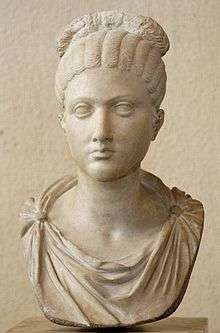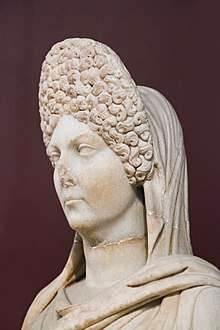Janet Stephens
Janet Stephens (née Scott) is a hairstyle archaeologist[1] who reconstructs historical hairstyles, including those of Ancient Rome, aiming to prove that they were not done with wigs, as commonly believed, but with the person's own hair through demonstration of techniques and materials,[2] through original source material and analysis of statue's hairstyles.[3]


Early life
Her maiden name is Janet Scott, and she grew up in Kennewick, Washington.[4]
Reconstruction
She first became interested in this work in 2001, when she visited the Walters Art Museum in Baltimore and saw some statue busts from the Greek and Roman collections.[5][6] Stephens said,
I had never seen the back of a Roman statue before—they are usually placed high on shelves/pedestal[s] with the backs tight up against a wall. As I circled the portraits I saw the logic of the hairstyles and determined to try some at home.[5]
But she found that scholars mainly believed that the hairstyles were wigs.[2] Believing otherwise, Stephens set out to do her own research.[2] In 2005, while studying translations of Roman literature, she realized the Latin term acus, which has several meanings including a "single-prong hairpin" or "needle and thread," was being mistranslated as "single-prong hairpin" in the context of ancient Roman hairdressing.[2] While single-prong hairpins could not have held up the elaborate hairstyles of ancient Rome, a needle and thread could.[2]
In 2008 she published this theory as "Ancient Roman Hairdressing: On (hair) pins and needles" in the Journal of Roman Archaeology, Vol. 21.[7][2] In 2012 her video Julia Domna: Forensic Hairdressing was presented at the Archaeological Institute of America’s annual meeting in Philadelphia.[8] In 2013 she became the first to recreate the hairstyle of the Roman vestal virgins on a modern person.[9][2][10]
Hairdressing
Stephens continues to work as a hairdresser at Baltimore's Studio 921 Salon and Day Spa.[11]
References
- Eveleth, Rose. "This Woman Is a Hair-Style Archaeologist". Smithsonian Magazine. Retrieved 2020-01-15.
- Pesta, Abigail (2013-02-06). "On Pins and Needles: Stylist Turns Ancient Hairdo Debate on Its Head - WSJ.com". Online.wsj.com. Retrieved 2013-10-15.
- "'Hairdo archaeologist' solves old mystery". BBC News. Retrieved 2020-04-12.
- Schilling, Sara. "Kennewick native featured in front-page Wall Street Journal Story on ancient hairstyles | Local News". Tri-CityHerald.com. Archived from the original on 2015-04-02. Retrieved 2013-10-15.
- "Blog Archive » Janet Stephens: Intrepid Hairdressing Archaeologist". The History Blog. Retrieved 2013-10-15.
- ""Hairdressing Archaeologist" Re-Writes History". Modernsalon.com. 2013-02-20. Retrieved 2013-10-15.
- "Studio 921 Salon & Day Spa". Studio921spa.com. Retrieved 2013-10-15.
- http://www.thehistoryblog.com/archives/14729
- "Roman vestal virgin hairstyle re-created - Technology & science - Science - LiveScience". NBC News. 2013-01-09. Retrieved 2013-10-15.
- Carusillo, Claire. "Janet Stephens - New York Magazine". NYMag. Retrieved 2020-04-12.
- Schilling, Sara. "Kennewick native featured in front-page Wall Street Journal Story on ancient hairstyles | Local News". Tri-CityHerald.com. Archived from the original on 2015-04-02. Retrieved 2013-10-15.